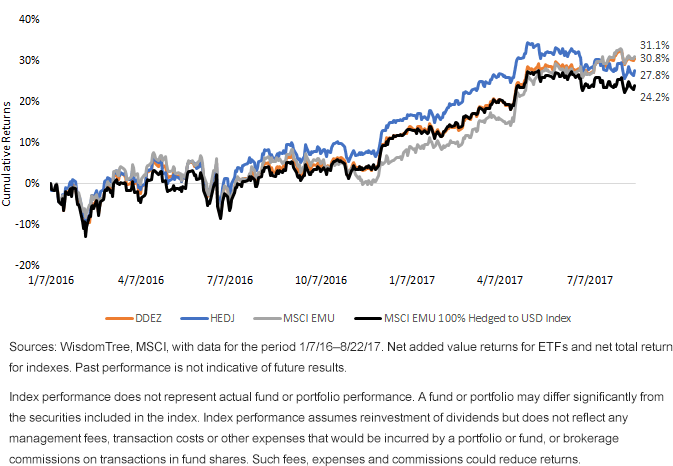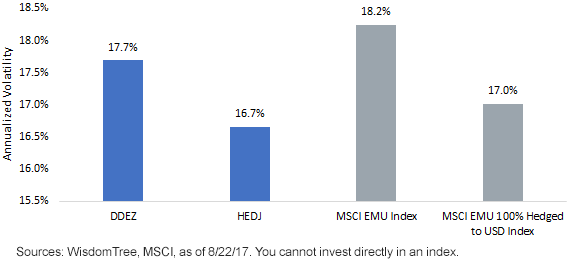Time To Get Bullish On The Euro? Why We Would Incorporate A Dynamic Approach
One of the big stories this year has been the weakness in the U.S dollar after a strong run in the second half of 2016. A confluence of factors is affecting the euro—from politics in the U.S. to monetary policy shifts that may occur later this year in the eurozone.
This has caused a shift in the attention of investors, from a focus on currency-hedged strategies that have the goal of isolating the equity market returns alone to “double decker” strategies that add currency risk on top of the equity returns.
Strategically, I believe there is a case to hold hedged strategies over the long run to reduce the uncertainty that comes with currencies. Sure, the euro is on a hot streak at the moment—but this is far from a sure sign to add value always and forever as unhedged strategies dictate. The euro’s volatilityover the last 20 years has been 10%—and the average annual move in either direction plus or minus 9%.1
Is now the time to turn more tactically bullish on the euro?
The increased flows to unhedged European stock exposures mean—whether intentionally or unintentionally—investors are taking on more euro risk. Instead of always being long the euro on top of equities, for those who wish to add in currency risk, WisdomTree has been advocating a dynamic factor model to determine how much risk to hedge or keep exposed.
Our currency factor model uses three factors to determine the hedge ratio: interest rate differentials, value and momentum.
- The interest rate differentials will suggest staying hedged the euro for some time—and would largely require the European Central Bank to hike rates to higher levels than the U.S. Federal Reserve (Fed). This will mandate that WisdomTree’s dynamic hedged Indexes offer a minimum one-third hedge ratio on the euro for an extended period. Our research has shown that when you were paid to hedge like you are today, that interest rate differential on average offset any gains that came in the currencies—this was one of strongest factors in our research.
- Momentum: The reason that many have become more bullish on the euro is that it just started appreciating. Our momentum model evaluates the 10-day moving average of currencies compared with the 240-day moving average. This signal is currently unhedged with the euro’s positive momentum and will remain there until the 10-day moving average crosses back below the 240-day moving average.
- Value: Our fair value model for the euro reduced the hedge ratio earlier this year. The euro crossed below our 20% undervalued threshold on a purchasing power parity basis and will remain unhedged on that model for some time.
We launched the WisdomTree Dynamic Currency Hedged Europe Equity Fund (DDEZ), in January 2016. Over the ensuing period, it has outperformed both the fully hedged index from MSCI by approximately 660 basis points (bps) cumulatively and lagged the unhedged index by less than 40 bps cumulatively.
The WisdomTree Europe Hedged Equity Fund (HEDJ), which focuses on the exporters of Europe, was able to outperform the MSCI EMU (European Economic and Monetary Union) 100% Hedged to USD Index by 362 bps—this performance was due to its stock selection and weighting compared to a market cap index. While many have looked at this as a tactical play on Europe, we still advocate this as a core position of quality European stocks that have lower volatility than traditional unhedged European strategies.
Cumulative Returns (1/7/16–8/22/17)

European Equity Returns (1/7/2016 - 8/22/2017)

From a volatility perspective, the hedged indexes, which are more like a pure equity strategy compared to the “double decker” equity plus currency strategies, will show lower volatility. Looking at annualized daily volatility levels, because we have a short period of the live dynamic hedged index, you can see the differentials in volatility.
Annualized Volatility (1/7/16 - 8/22/17)

The euro has contributed to returns for international investors this year, but this may not always be the case. I remember when many contrarians looked at the flows going to hedged strategies and suggested smarter investors should “go the other way.” I’d argue that to lean against the vast tide today would be to move back toward hedged indexes for the eurozone and not in the double-decker funds. But if you think one can add value in rotating the hedge ratios and do not want to make a subjective determination, WisdomTree believes its quantitative and rules-based factor model will likely add value over time compared to both hedged and unhedged offerings.
1Volatility measured as the standard deviation of daily returns for the period 4/30/1998–8/22/2017. Average annual move measured for the period 12/31/1998–12/30/2016.
Disclaimer: Investors should carefully consider the investment objectives, risks, charges and expenses of the Funds before investing. U.S. investors only: To obtain a prospectus containing this ...
more


